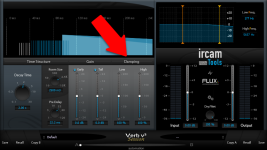"Reverb Damping" refers to how much "high frequency" absorption is going to be simulated by a reverb plugin or a reverb hardware unit.
For example, a hall that has a multitude of people will produce a unique reverberation sound compared to an empty one. Therefore, we can deduce that a hall packed with many people has a greater amount of reverb absorption of "high frequencies" than a hall without any soul.
Of course, reverb isn't necessarily used to only simulate real-world scenarios. Reverb can also be used for sound design purposes, in which the sound is purposely made to divert from normal conventions.
How To Simulate A Fast Decay of High Frequencies
A room that's full of people can be simulated with a fairly high amount of reverb damping. Meaning you have to increase the value of the damping control on your reverb plugin to get that sound.
The end result will be a quicker absorption or attenuation of high frequencies. And that's due to the "damping" effect which makes high frequencies lose energy a little faster.
How To Simulate A Slow Decay Of High Frequencies
A low setting of reverb damping results in a heightened sense of high frequencies. In other words, this is great for simulating empty rooms and halls.
The important thing to remember is an empty room means less absorption of high frequencies. So if you want a brighter reverb sound then reduce the level of damping.
How To Use Reverb Damping When Mixing Music
It's very essential to say every mix is different. So you are always advised to use discretion when applying effects such as reverb, delays, and so forth.
For instance, let's say you want a warmer reverb sound. In that case, you can try to increase the reverb plugin's damping parameter to match your desired sound. If that's not enough you could always use an EQ after the reverb to shape your sound precisely.
After all, there is an inverse relationship between the damping effect and the sound you will be going for. Meaning if your reverb sound has to be bright (high-end frequencies) then your damping has to be set at a low value.
Low-Frequency Damping Control For Reverb Plug-ins
Although a high-frequency reverb damping parameter is common in almost every reverb you can think of, don't be surprised when you come across some reverb plugins which have the "low-frequency damping control."
The main function of this low-frequency damping parameter usually does the same type of action as the high damping function you are used to except now the low frequencies will be absorbed much faster depending on the settings you dial in.
For example, a hall that has a multitude of people will produce a unique reverberation sound compared to an empty one. Therefore, we can deduce that a hall packed with many people has a greater amount of reverb absorption of "high frequencies" than a hall without any soul.
Of course, reverb isn't necessarily used to only simulate real-world scenarios. Reverb can also be used for sound design purposes, in which the sound is purposely made to divert from normal conventions.
How To Simulate A Fast Decay of High Frequencies
A room that's full of people can be simulated with a fairly high amount of reverb damping. Meaning you have to increase the value of the damping control on your reverb plugin to get that sound.
The end result will be a quicker absorption or attenuation of high frequencies. And that's due to the "damping" effect which makes high frequencies lose energy a little faster.
How To Simulate A Slow Decay Of High Frequencies
A low setting of reverb damping results in a heightened sense of high frequencies. In other words, this is great for simulating empty rooms and halls.
The important thing to remember is an empty room means less absorption of high frequencies. So if you want a brighter reverb sound then reduce the level of damping.
How To Use Reverb Damping When Mixing Music
It's very essential to say every mix is different. So you are always advised to use discretion when applying effects such as reverb, delays, and so forth.
For instance, let's say you want a warmer reverb sound. In that case, you can try to increase the reverb plugin's damping parameter to match your desired sound. If that's not enough you could always use an EQ after the reverb to shape your sound precisely.
After all, there is an inverse relationship between the damping effect and the sound you will be going for. Meaning if your reverb sound has to be bright (high-end frequencies) then your damping has to be set at a low value.
Low-Frequency Damping Control For Reverb Plug-ins
Although a high-frequency reverb damping parameter is common in almost every reverb you can think of, don't be surprised when you come across some reverb plugins which have the "low-frequency damping control."
The main function of this low-frequency damping parameter usually does the same type of action as the high damping function you are used to except now the low frequencies will be absorbed much faster depending on the settings you dial in.

